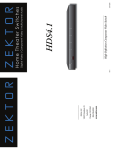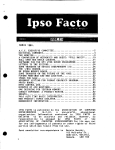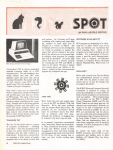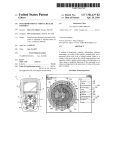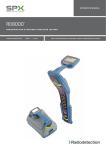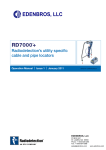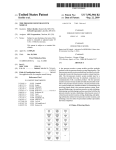Download Detector for detecting a current carrying conductor and a method of
Transcript
US008115489B2 (12) United States Patent (10) Patent N0.: (45) Date of Patent: Pearson et al. (54) DETECTOR FOR DETECTING A CURRENT CARRYING CONDUCTOR AND A METHOD OF VALIDATING OPERATION OF THE DETECTOR (75) Inventors: Richard David Pearson, Bristol (GB); Kevin Conway, Newport (GB) (73) Assignee: Radiodetection Limited, Bristol (GB) (*) Notice: Subject to any disclaimer, the term of this patent is extended or adjusted under 35 U.S.C. 154(b) by 295 days. 7,403,012 B2 * 7,847,556 B2 * 7,969,137 B2 * 7/2008 12/2010 6/2011 US 8,115,489 B2 Feb. 14, 2012 Worsley et al. ............. .. 324/326 Royle .......... .. 324/326 Royle ....... .. 324/329 7,994,770 B2 * 8/2011 Royle et a1. . 324/329 2003/0058961 A1* 3/2003 Fling et al. ....... .. 375/316 2006/0284610 A1* 12/2006 Thompson et al. 2006/0284616 A1* 12/2006 Pearson et al. 2007/0290672 A1 * 2009/0243583 A1* 2010/0001712 2010/0001713 2010/0001714 2010/0001731 2010/0001732 A1* A1* A1* A1* A1* 2010/0004880 A1* 12/2007 Worsley et al. .... 324/67 324/326 . . . .. 10/2009 Olsson et al. .. 324/67 324/67 1/2010 Royle et a1. 324/67 1/2010 Royle . . . . . . . . . . . . .. 324/67 1/2010 Royle . . . . . . . . . . . . .. 324/67 1/2010 Royle et a1. . 1/2010 Royle et a1. 1/2010 .. 324/326 324/326 Royle et a1. ................. .. 324/326 FOREIGN PATENT DOCUMENTS (21) App1.No.: 12/395,838 (22) Filed: Mar. 2, 2009 (65) Prior Publication Data US 2010/0060285 A1 (30) (51) (GB) ................................. .. 08038739 Int. Cl. G01V3/08 (2006.01) (52) Us. or. ..................................................... .. 324/326 (58) Field of Classi?cation Search ...................... .. None See application ?le for complete search history. (56) References Cited 202004006336 0036257 0735377 2349841 2006-275959 U1 A1 A2 A1 A 8/2004 9/1981 3/1996 12/1977 10/2006 OTHER PUBLICATIONS Mar. 11, 2010 Foreign Application Priority Data Feb. 29, 2008 DE EP EP FR JP “RD4000 Locating System User Manual, Rev 3,” Radiodetection Limited, Oct. 2002. * cited by examiner Primary Examiner * Jer'mele M Hollington (74) Attorney, Agent, or Firm * Baker & Hostetler LLP (57) ABSTRACT A detector for detecting a buried conductor comprises a plu rality of antennas B, T. Each antenna B, T has a Winding Wound around the antenna, the Winding being connected to a current source for providing a prede?ned current in the Wind U.S. PATENT DOCUMENTS 4,387,340 A 5,043,666 A 5,541,516 A 6/1983 Peterman 8/1991 Tavernettiet a1. 7/1996 Rideret a1. 6,728,662 B2* 7,091,872 B1* 4/2004 8/2006 Frost et a1. .................... .. 324/66 Bigelow et a1. ............. .. 340/664 7,336,078 B1 2/2008 Merewether et a1. 7,342,537 B2* 3/2008 Pearson et a1. .............. .. 342/459 ing. When the prede?ned current is applied to the Winding an electromagnetic ?eld is generated at the antenna Which induces a test current in the antenna. The test current is com pared to calibration data stored in the detector to validate the correct operation of the detector. 20 Claims, 2 Drawing Sheets US. Patent Feb. 14, 2012 Sheet 1 012 US 8,115,489 B2 Receiver Transmitter Figure 1 23 5\ PSU 1 // 3 Antennas 1 I // 5 S|gna| Processor Controller I ul/ Figure 2 2 / —|_ / //—j—Comms /-19 /' 21 Memory US. Patent Feb. 14, 2012 Figure 3 Sheet 2 M2 “/r31 US 8,115,489 B2 s 27\ Figure 4 US 8,115,489 B2 1 2 DETECTOR FOR DETECTING A CURRENT CARRYING CONDUCTOR AND A METHOD OF VALIDATING OPERATION OF THE DETECTOR The processor may be con?gured to store results of the test in the memory. The detector may further comprise a user interface for conveying the results of the test to a user and a communica tions module for transmitting results of the test to another device. According to a second aspect of the invention there is provided a system for validating the operation of a detector as CROSS REFERENCE TO RELATED APPLICATIONS This application claims priority to United Kingdom Patent Application GB 0803873.9, ?led on Feb. 29, 2008, and entitled “A Detector for Detecting a Current Carrying Con ductor and a Method ofValidating Operation of the Detector,” the disclosure of Which is incorporated herein by reference in de?ned above, the system comprising: a microprocessor-con trolled device having a communications module for commu nicating With the communications module of said detector and a communications module for accessing a netWork, Wherein the device is con?gured to receive test results from said detector and transmit the test results to said netWork. The system may further comprise a server connected to said netWork, Wherein the server is con?gured to receive test its entirety. FIELD OF THE INVENTION The present invention relates to a detector for detecting a current carrying conductor and a method of validating opera tion of the detector. results from the microprocessor-controlled device. The server may be con?gured to generate a calibration certi?cate 20 if the test results indicate that said detector is operating Within predetermined limits, the calibration certi?cate being doWn BACKGROUND OF THE INVENTION Before commencing excavation or other Work Where elec trical cables, ?bre optic cables or other utilities ducts or pipes are buried, it is important to determine the location of such 25 comprising: providing a prede?ned current in the Winding to generate an electromagnetic ?eld at each antenna, thereby buried cables or pipes to ensure that they are not damaged during the Work. Current carrying conductors emit electromagnetic radia inducing a test current in each antenna; and processing the test tion Which can be detected by an electrical antenna. If ?bre optic cables or non-metallic utilities ducts or pipes are ?tted With a small electrical tracer line, an alternating electrical current can be induced in the tracer line Which in turn radiates electromagnetic radiation. It is knoWn to use detectors to 30 detect the electromagnetic ?eld emitted by conductors carry 35 currents to determine if the test currents are Within predeter mined limits of the calibration data. The predetermined limits for each antenna may be the ing alternating current. Once a buried utility is located the depth of the utility can be calculated to determine a safe excavation depth. It is calibration data 10.01%. The processor may disable the detector if one of the test currents is outside the predetermined limits of the calibration data. The plurality of antennas may comprise tWo or three par allel antennas Which in use are oriented horizontally and spaced vertically. The processor may store results of the test in the memory important that the depth information provided to the operator is accurate so as to avoid damage to the buried utility or injury to person When excavating the area. loadable from the server to the microprocessor-controlled device. The netWork may be the Internet. According to a third aspect of the invention there is pro vided a method of validating the operation of a detector for detecting a buried conductor as de?ned above, the method 40 and the test may be conveyed to a user via a user interface. The method may further comprise: providing the detector With a communications module; providing a microprocessor SUMMARY OF THE INVENTION controlled device having a communications module for com municating With the communications module of the detector; Embodiments of the present invention advantageously pro 45 and transmitting the results of the test from the detector to the vide a detector for detecting a current carrying conductor and microprocessor-controlled device via the communications a method of validating operation of the detector. According to a ?rst aspect of the invention there is provided modules. a detector for detecting a buried conductor, the detector com processor-controlled device With a communications module for accessing a netWork; and transmitting results of the test from the microprocessor-controlled device to said netWork. The method may further comprise: providing a server con nected to said netWork; and transmitting results of the test The method may further comprise: providing the micro prising: a plurality of antennas for detecting an electromag netic ?eld; a plurality of Windings, each Wound around a respective antenna, each Winding being connected to a cur rent source for providing a prede?ned current in the Winding to generate an electromagnetic ?eld at the antenna, thereby 50 inducing a test current in the antenna; a memory for storing calibration data of the antennas; and a processor con?gured to process the test currents in the antennas to determine if the test currents are Within predetermined limits of the calibration data. The predetermined limits for each antenna may be the calibration data 10.01%. The processor may be con?gured to disable the detector if one of the test currents is outside the predetermined limits of the calibration data. The plurality of antennas may comprise tWo or three par allel antennas Which in use are oriented horizontally and 55 spaced vertically. from the microprocessor-controlled device to the server over said netWork. The method may further comprise: generating a calibration certi?cate at the server if the test results indicate that the detector is operating Within predetermined limits and doWn loading the calibration certi?cate from the server to the 60 microprocessor-controlled device. The netWork may be the Internet. The detector described above may further comprise a hous ing in Which the other components of the detector are housed, Wherein the detector is portable. 65 According to a further aspect of the invention there is provided a system for detecting a buried conductor compris ing: a transmitter for generating an alternating current test US 8,115,489 B2 3 4 signal in said conductor; and a detector as de?ned above for signal representative of the electromagnetic ?eld 11 at the detecting the signal generated in said buried conductor by the antenna. The outputs from the antenna module 13 are fed into transmitter. a signal processor module 15 for isolating signals of a desired frequency band or bands and processing these signals to There has thus been outlined, rather broadly, certain embodiments of the invention in order that the detailed derive their characteristics using knoWn techniques. The sig description thereof herein may be better understood, and in nal processor module 15 may comprise a pre-ampli?cation order that the present contribution to the art may be better appreciated. There are, of course, additional embodiments of the invention that Will be described beloW and Which Will antennas if the detected signal is Weak. The signal processor module 15 may further comprise an analogue to digital con stage for amplifying the ?eld strength signals output from the form the subject matter of the claims appended hereto. ver‘ter for converting the ?eld strength signals into digital signals and a digital signal processor for processing the digi tised signals. In this respect, before explaining at least one embodiment of the invention in detail, it is to be understood that the invention is not limited in its application to the details of construction and to the arrangements of the components set forth in the folloWing description or illustrated in the draW ings. The invention is capable of embodiments in addition to those described and of being practiced and carried out in various Ways. Also, it is to be understood that the phraseology and terminology employed herein, as Well as the abstract, are for the purpose of description and should not be regarded as The receiver comprises a communications module 17 to provide a communication/data link betWeen the receiver 5 and a microprocessor-controlled device such as a personal computer (PC) or a personal digital assistant (PDA) (not 20 limiting. As such, those skilled in the art Will appreciate that the conception upon Which this disclosure is based may readily be utiliZed as a basis for the designing of other structures, methods and systems for carrying out the several purposes of the present invention. It is important, therefore, that the claims be regarded as including such equivalent constructions insofar as they do not depart from the spirit and scope of the present invention. 25 screen and an audible output device such as a speaker or beeper. The receiver 5 further comprises a memory module 21 and a poWer supply unit (PSU) 23 comprising poWer man agement circuitry and a poWer source such as batteries. The 30 BRIEF DESCRIPTION OF THE DRAWINGS FIG. 1 is a schematic representation of a detector system for detecting a buried conductor according to an embodiment of the invention. FIG. 2 is a block diagram of the detector of the system of FIG. 1. FIG. 3 is a representation of tWo antennas of the detector of FIG. 2. FIG. 4 shoWs a system for validating operation of the When the receiver is located over a current carrying con 35 40 45 draWing ?gures, in Which like reference numerals refer to like antennas B, T. In use the detector 5 is held vertical on ground 27 in Which a current carrying conductor 7 is buried, With the bottom antenna B close to the surface of the ground 27. The axes of the antennas are parallel and the separation betWeen the bottom antenna B and the top antenna T is 2s. The con ductor 7 is buried at a depth d beloW the surface of the ground 27 (and beloW the bottom antenna B) and the horiZontal displacement betWeen the antennas B and T and the conduc tor 7 is x. The components of the portable detector 5 are housed in a housing (not shoWn). parts throughout. table receiver/ detector 5. The transmitter 3 is placed in prox imity to a buried conductor 7 to produce an alternating current test signal in the buried conductor 7. An aerial in the transmitter 3 is fed With an AC voltage to produce an electromagnetic ?eld 9 Which links With the bur comparing the current induced in at least tWo of the antennas in the antenna module 13. FIG. 3 shoWs an antenna module 13 of a detector 5 comprising tWo horiZontal vertically spaced DETAILED DESCRIPTION FIG. 1 is a schematic representation of a system 1 for detecting a buried conductor according to an embodiment of the invention, comprising a portable transmitter 3 and a por overall control of the various components of the receiver 5 is managed by a controller 25. ductor Which radiates an electromagnetic ?eld, the depth of the conductor can be calculated using knoWn techniques by detector of FIG. 2. The invention Will noW be described With reference to the shoWn). The communication link may be implemented via a Wired or Wireless connection. Additionally the communica tions module 17 may provide a communication link With the transmitter 3. A user interface module 19 is provided to convey informa tion to the operator of the receiver 5 and may comprise one or more of a display for displaying information to the operator of the device, input devices such as a keypad or a touch sensitive 50 When an alternating current ?oWs in the conductor 7 and the conductor 7 radiates an electromagnetic ?eld, the mag netic ?ux density or magnetic ?eld at the bottom antenna B is BB and the magnetic ?ux density at the top antenna T is B T. The depth of the buried conductor 7 beloW the surface 27 of the ground is given by: 55 ied conductor 7, thereby inducing the alternating current test signal in the buried conductor 7. The alternating current test signal is radiated as an electromagnetic ?eld 11 by the buried conductor 7 and this electromagnetic ?eld can be detected by the receiver 5. In other embodiments the transmitter may provide a test signal in the conductor by direct connection to the conductor or by clamping around the conductor, as is 60 knoWn in the art. FIG. 2 is a block diagram of the receiver 5 of the system 1 of FIG. 1. An electromagnetic ?eld 11 radiated by the buried conductor 7 is detected by a plurality of antennas in an antenna module 13. Each antenna outputs a ?eld strength 65 It can be seen from the above equation that in order to produce an accurate depth calculation the outputs from the bottom antenna B and the top antenna T must be correctly calibrated With respect to each other. The calibration of the top antenna T relative to the bottom antenna B is performed When the detector is set up after manufacture and factory calibration data is stored in the memory 21. This invention provides a detector Which can perform a self-test to ensure US 8,115,489 B2 5 6 that the calibration of the antennas is Within acceptable limits and a method of validating the operation of the detector. In the detector 5 of FIGS. 2 and 3 each antenna B, T is person skilled in the art that the detector may comprise three parallel horiZontal antennas or more and that some or all of the antennas may comprise a Winding Wound around the provided With a Winding 29 (shoWn in dotted lines) Which is ferrite of the antenna and connected to a precision current source to provide an integrated built-in test capability for Wound around the ferrite of the antenna and connected to a precision current source 31 (shoWn in dotted lines) to provide an integrated built-in test capability. After the relative cali some or all of the antennas. Aspects of the present invention canbe implemented in any convenient form, for example using dedicated hardWare, or a mixture of dedicated hardWare and softWare. The processing apparatuses can comprise any suitably programmed appara tuses such as a general purpose computer, personal digital assistant, mobile telephone (such as a WAP or 3G-compliant bration of the top antenna T and the bottom antenna B is performed in the factory, separate calibration data is gener ated in the factory for the top antenna T and for the bottom antenna B by using the precision current source 31 of each antenna to generate a known, prede?ned current in the Wind ing 29 and recording the current induced in the antennas B, T. This calibration data is stored in the memory 21 of the detec phone) and so on. Since the present invention can be imple mented as softWare, each and every aspect of the present tor 5 so that it is available for future calibration self-tests. invention thus encompasses computer softWare implement If it is desired to check that the detector 5 is still performing Within its calibration limits then the user initiates the calibra be provided to the programmable device using any conven able on a programmable device. The computer softWare can tion procedure through the user interface 19. The prede?ned tional carrier medium. The carrier medium can comprise a transient carrier medium such as an electrical, optical, micro test current is generated by the precision current sources 31 and passed through the Windings 29 to produce electromag 20 netic ?elds at the antennas B, T Which induces test currents in the respective antennas B, T. The test currents output from the antennas B, T are compared to the factory calibration data stored in the memory 21 for each antenna B, T to verify that the currents are Within predetermined limits of the factory calibration data. If the currents output from both of the anten nas B, T are Within the predetermined limits then the calibra tion test is deemed to be a pass. The predetermined limit for each antenna is that the test current is Within the factory calibration data 10.01% (i.e., 1 part in 10,000). If the current output from one of the antennas B, T is not Within the prede termined limits then the calibration test is deemed to be a fail. The results of the integrated built-in test are conveyed to the TCP/IP signal carrying computer code over an IP netWork, such as the lntemet. The carrier medium can also comprise a storage medium for storing processor readable code such as a 25 apparent from the detailed speci?cation, and, thus, it is 30 35 40 ?eld, a plurality of Windings, each Wound around a respective antenna, each Winding being connected to a current 45 The PC 33 and PDA 35 are connected or connectable via a netWork 37, such as the lntemet, to a server 39. The server 39 source for providing a prede?ned current in the Wind ing to generate an electromagnetic ?eld at the antenna, thereby inducing a test current in the antenna, a memory for storing calibration data of the antennas, 50 The results of the calibration test together With an identi?er of the detector 5, such as a serial number, can be uploaded from the memory 21 of the detector 5 to the PC 33 or PDA 35 a processor con?gured to process the test currents in the antennas to determine if the test currents are Within predetermined limits of the calibration data, and and from there via the netWork 37 to a server 39 so that the 55 a communications module for transmitting calibration test results; and a microprocessor-controlled device for receiving the cali bration test results from the detector. 2. The system according to claim 1, Wherein the predeter mined limits for each antenna are the calibration data 10.01%. 3. The system according to claim 1, Wherein the processor a test pass certi?cate Which can be doWnloaded to the PC 33 or PDA 35. A printer 43 connected to the PC 33 can print the calibration certi?cate to shoW that the detector 5 passed the calibration test on the date in question. Various modi?cations Will be apparent to those in the art and it is desired to include all such modi?cations as fall Within 60 the scope of the accompanying claims. For example, the detector 5 shoWn in the Figures comprises 65 tWo parallel horiZontal antennas. It Will be understood by a 1. A system for detecting a buried conductor, comprising: a detector, including: a plurality of antennas for detecting an electromagnetic embodiments the detector 5 may communicate via a Wired connection. results can be stored in the memory 41 associated With the server 39 to record the test results and Whether the detector 5 passed or failed the calibration test on the date in question. If the calibration test Was passed then the server 39 can generate and, accordingly, all suitable modi?cations and equivalents We claim: PC 33, a PDA 35 or other microprocessor-controlled device can access a storage device 41. intended by the appended claims to cover all such features and advantages of the invention Which fall Within the true spirit and scope of the invention. Further, since numerous modi?cations and variations Will readily occur to those skilled in the art, it is not desired to limit the invention to the exact construction and operation illustrated and described, may be resorted to that fall Within the scope of the invention. munications module 17 With a communications module of a (not shoWn). In the system of FIG. 4 the detector 5 commu nicates Wirelessly With the PC 33 and PDA 35 but in other ?oppy disk, hard disk, CD ROM, magnetic tape device or solid state memory device. The many features and advantages of the invention are user by means of the user interface 19 and stored in the memory 21. If the detector 5 fails the integrated built-in test then a Warning is displayed to indicate that the detector 5 is out of calibration. Alternatively or additionally the controller 25 may lock the detector 5 to prevent its use until the detector is recalibrated and the integrated built-in test is passed. FIG. 4 shoWs a system for validating the operation of the detector of FIG. 2. The detector 5 communicates via its com Wave, acoustic or radio frequency signal carrying the com puter code. An example of such a transient medium is a is con?gured to disable the detector if one of the test currents is outside the predetermined limits of the calibration data. 4. The system according to claim 1, Wherein the plurality of antennas comprise tWo parallel antennas Which in use are oriented horiZontally and spaced vertically. 5. The system according to claim 1, Wherein the plurality of antennas comprise three parallel antennas Which in use are oriented horiZontally and spaced vertically. US 8,115,489 B2 8 7 6. The system according to claim 1, wherein the processor transmitting calibration test results from the detector to a is con?gured to store results of the test in the memory. microprocessor-controlled device. 7. The system according to claim 1, Wherein the detector 13. The method according to claim 12, Wherein the prede further comprises a user interface for conveying the calibra termined limits for each antenna are the calibration data 10.01%. tion test results to a user. 8. The system according to claim 1, further comprising: 14. The method according to claim 12, further comprising a transmitter for generating an alternating current test sig nal in said conductor. disabling the detector if one of the test currents is outside the predetermined limits of the calibration data. 15. The method according to claim 12, Wherein the plural ity of antennas comprise tWo parallel antennas Which in use are oriented horiZontally and spaced vertically. 16. The method according to claim 12, further comprising storing the calibration test results in the memory. 17. The method according to claim 12, further comprising 9. The system according to claim 1, further comprising a server connected to a netWork, Wherein the microprocessor controlled device transmits the calibration test results to the server over the network. 10. The system according to claim 9, Wherein the server is con?gured to generate a calibration certi?cate if the test results indicate that said detector is operating Within prede termined limits. 11. The system according to claim 10, Wherein the calibra conveying the calibration test results to a user via a user tion certi?cate is doWnloadable from the server to the micro 18. The method according to claim 12, further comprising: transmitting the calibration test results from the micropro interface. processor-controlled device. 12. A method of validating the operation of a detector for detecting a buried conductor, the detector including a plural ity of antennas, a plurality of Windings, each Winding Wound 20 generating a calibration certi?cate at the server if the cali around a respective antenna and connected to a current source, a memory, a processor and a communications mod bration test results indicate that the detector is operating ule, the method comprising: providing a prede?ned current in the Winding to generate an electromagnetic ?eld at each antenna, thereby induc ing a test current in each antenna; processing the test currents to determine if the test currents are Within predetermined limits of the calibration data; and cessor-controlled device to a server over a netWork. 19. The method according to claim 18, further comprising: 25 Within predetermined limits. 20. The method according to claim 19, further comprising: doWnloading the calibration certi?cate from the server to the microprocessor-controlled device.







